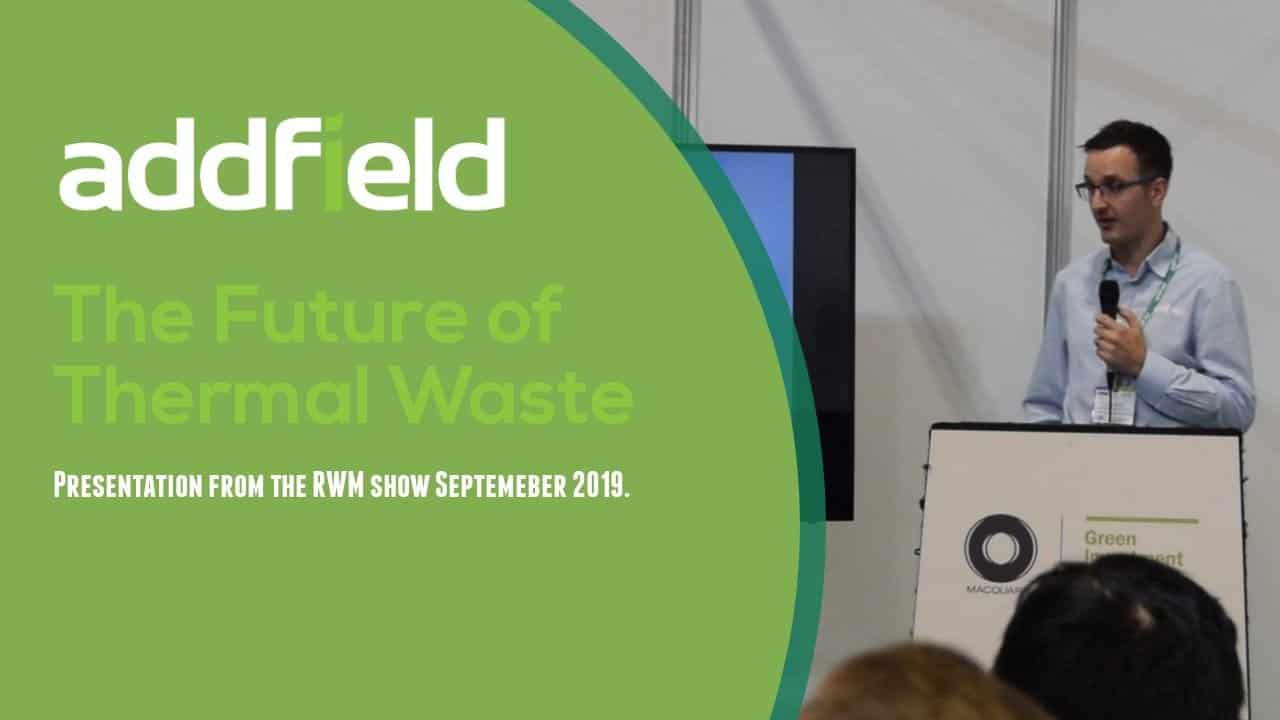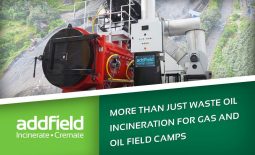The future of Waste to Energy – Complete talk by James Grant – Addfield Environmental.
In September 2019 during the first day of the Recycling and Waste Management Exhibition at the NEC in Birmingham. Our Business Development Director James Grant delivered an information-packed presentation to a packed lecture theatre about the future of Waste to Energy and the ways in which Addfield is supporting the development for our customers.
The following is an optimised transcript of the presentation giving you the highlights of the talk.
If you have any questions on how Addfield can help you at the end of this contact us straight away via sales@addfield.com.
The Future of Waste Treatment
At Addfield we have become a recognised and respected provider of thermal waste treatment solutions able to provide a reaching range of solutions from individual small-scale machines through to full high capacity facilities.
I would like to describe to you how these plants can help you with your waste issues. Hopefully, you will be able to identify with some of the problems identified here.
We have been manufacturing incinerators for over 35 years and currently export our equipment to over 100 different countries around the world.
To begin with an introduction to the points that we are going to discuss.
Starting with a brief overview of the current risks to waste management and how we can address those.
Followed by a review of our small-scale waste to energy plants and the permits surrounding them, before discussing planning. Finally, we will look at your ‘Return on Investment’ in these plants and the main factors as to why you would want to look at something like this.
Risks To Waste Management
Starting off, risks to waste management and why you may want to look into something like this. Firstly something that maybe everyone can identify with and that is ever-increasing landfill costs. In recent years they have just increased and increased, in gate fees as well as transport costs.
There is a potential lack of landfill capacity in the UK, resulting in a lot of recent news reports talking about landfill problems especially with regards to exporting waste abroad. And potential tariffs on waste as well which we will go into more detail later. Where a lot of countries around the world are placing import taxes and again risks from Brexit exporting waste to EU countries.
Another risk to waste especially plastics is the reclassification of certain waste types so there is a potential for certain plastics such as car plastics are to be reclassified as hazardous. This would have an impact on how they are disposed of and also affect the cost associated with that disposal as well. Finally, there is a rejection of waste from traditional waste importing countries.
Waste Makes Headlines
There have been several news reports on waste from all over the world, and how government policy impacts waste disposal costs and how that might challenge future waste disposal routes.
Here are a couple of examples – there are lots of these that keep cropping up on the news I am sure you have seen some.
Here we have ‘Malaysia sends back 3000 tonnes of plastic back to the country of origin.’ This is just highlighting the issues of where waste goes in the future and the options for waste disposal are narrowing.
Equally just last year (2018) ‘China decides to ban 24 grades of rubbish,’ as part of their ‘National Sword,’ campaign. The main key point to take away from this is that China is probably the world’s biggest waste importer, so waste isn’t just an issue for the UK it is a global issue for how people treat their waste in the future.
Talking about tariffs here is an example of how potentially RDF is going to be taxed in January 2020 and this seems to be a running theme with taxation on waste in the future.
And then government policy, a little bit closer to home with landfill tax being a corner piece of Scotland’s ‘Zero Waste’ plan, where government pressure is on looking for where waste will go in the future.
I am going to identify certain areas and outlets for those as well. Hopefully, you can look at those and see where you may have problems with your waste.
Small Scale Waste to Energy Plants.
The future as we see it is small scale waste to energy plants.
What is small scale?
Well, small scale is for us a machine that processes less than three tones per hour and that comes down to permitting which we talk about later on.
Just to identify waste types that will be suitable for this kind of plant. Effectively a waste to energy plant can burn any type of waste. However, there are certain waste streams that are derived from oil such as plastics which will be a lot more cost effective to run through a combustion plant so if you have something of a higher energy value it uses less auxiliary fuel to run it. Equally, if you have something of a low energy value or a high moisture content you will use more fuel to run the plant and fuel is probably the biggest outgoing when running this kind of equipment.
You may recognise a few of these waste types:
- · Car plastics
- · Mixed polymers
- · WEEE waste,
- · MRF reject
Again all plastic derived really, and costs for disposal will come back to the ROI part.
The higher the energy value the quicker the return on investment.
What to expect from a small-scale waste to energy plant. We will discuss the most common layouts that we produce. However, every site is different and every waste type is different. So we build them to a customer requirement but these main points will ring true for most sites.
To access the full 20+ minute presentation and learn more about the opportunities available from a Waste to Energy Plant or High Capacity waste incineration contact James Grant on email at sales@addfield.com or telephone +44 01543 571280




